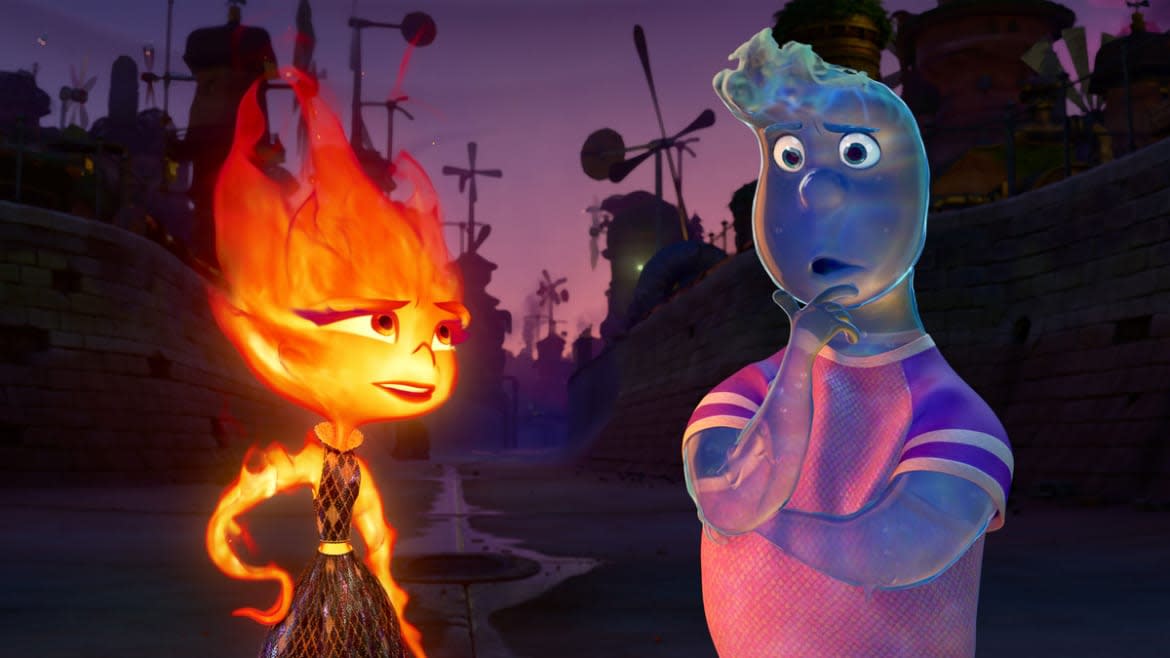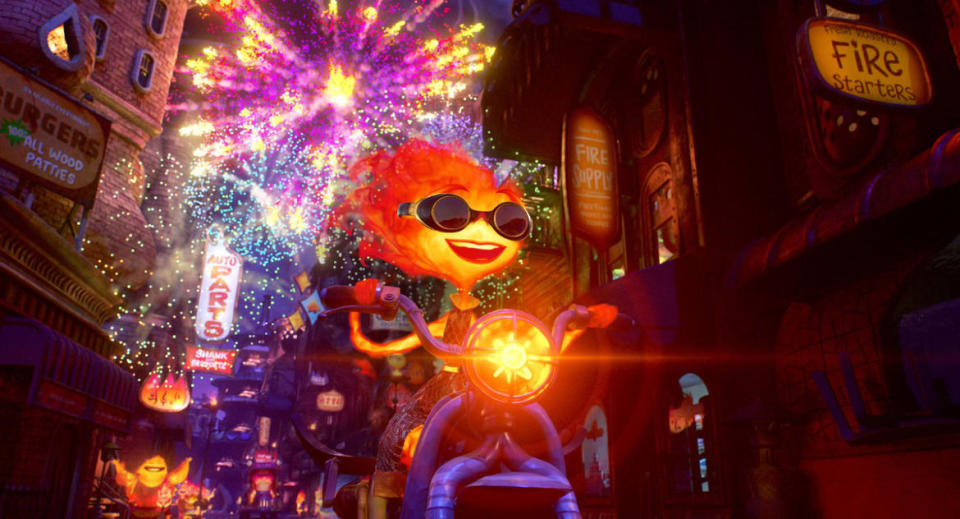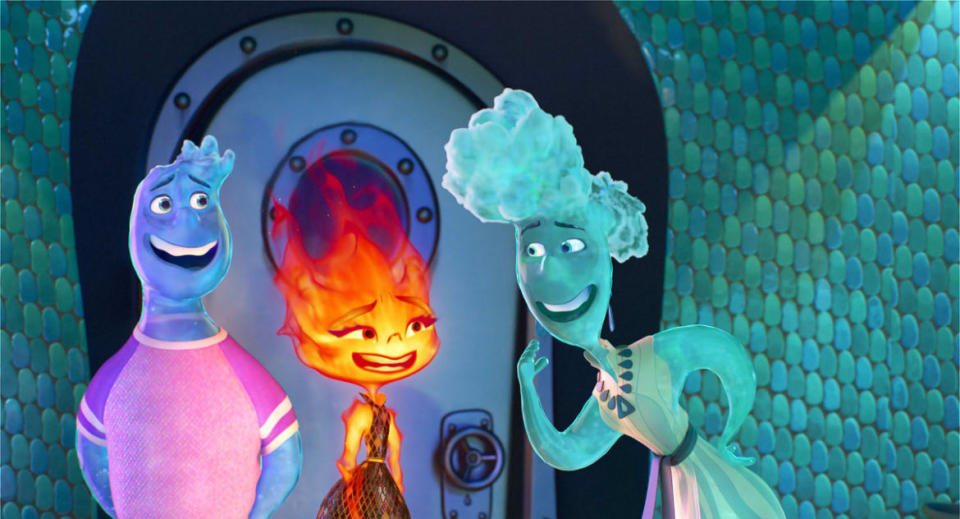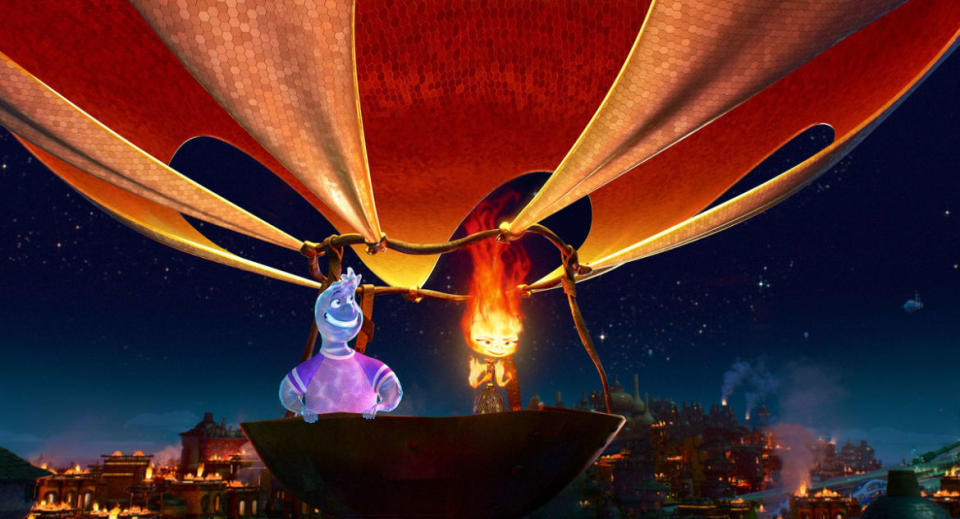Pixar Takes on Immigration With Lukewarm ‘Elemental’

- Oops!Something went wrong.Please try again later.
- Oops!Something went wrong.Please try again later.
In 2003, my dad took my sister and me to see a Pixar film for Father’s Day: Finding Nemo, a film more remarkable—and remarkably well-suited for the holiday—than any of us could have expected. This weekend, 20 years later, the three of us have a new holiday-appropriate Pixar pick for a Father’s Day outing. Elemental (in theaters June 18) is another emotions-heavy adventure about a parent and child’s efforts to understand each other. Although it doesn’t come close to reaching Nemo’s heights (very few films, animated or otherwise, can), Elemental neither needs nor tries to, mostly to its own benefit.
Instead of being a gorgeously reassuring tale for helicopter parents or upcoming empty nesters, à la Nemo, Elemental focuses on the children eager to chart their own paths—and maybe even start their own families. While not unheard of for Pixar, Elemental’s cast is almost exclusively composed of adults, ones with adult dreams. The characters have all your classic ol’ goals here: retirement; finding your soulmate; upward mobility out of the lowest rung of your society’s discriminatory class system. These familiar aims are filtered through a high-concept premise, one that feels less complicated than other conceptual Pixar fare like Soul and Inside Out, yet somehow less well-defined or explained. As Elemental tries to tell a straightforward story in this complex world, it unfortunately falls flat nearly as often as it soars.
Elemental takes place in a world divided into four tribes: fire, water, earth, and air. But the similarities to Avatar: The Last Airbender end there. These are actually communities of anthropomorphized elements, each with their own cultures and quirks—fire people, whose bodies are covered in flames, eat flint to keep themselves alight; water people’s homes are basically indoor pools. Unfortunately, some of those elements don’t mesh well with each other. That’s especially so for fire people, whose combustible bodies are both a danger to themselves and to others.
Bernie and Cinder find this out the hard way. The film opens upon them leaving their homeland to find a better life in the fantastical Element City. But as they pass through an Ellis Island-like port, they quickly find out that a world of differences is difficult to acclimate to—from the moment that the officer, upon asking their names and not understanding their native tongue, assigns them new, generically fire-themed ones.

Element City appears to be a utopia, with its bright blue sky and water, calm breeze, and bountiful trees, but it’s only that way for beings composed of the other three elements. For fire people, living among water, earth, and wind is a constant challenge. What if a water person touches and extinguishes them? What if they burn an earth person’s branch arms to a crisp? What if a wind person blows out the flames on their body that sustain them? Fire people have to fight off these constant fears, as do the other three sects that live comfortably in Element City when the fire people aren’t otherwise around.
Elemental uses these chemical properties to create a strong allegory for the difficulties that immigrants often face. Bernie, Cinder, their daughter Ember, and the rest of their fiery brethren are forced to live on the poorer outskirts of the city, in Fire Town. Fire Town is built with fireproof objects that provide safety for the close-knit community, where people of other elements rarely come to visit. Fire people have their own language, with characters occasionally dipping back into their untranslated native tongue. Bernie’s store, the Fireplace, serves as a stomping ground for the whole community—a general store that offers a sense of safety and understanding to people who often feel neither.
The world-building in Fire Town is delightful, especially when compared to the lack thereof in the other three elements’ own communities. We get few details on the social norms and niceties that define the water, earth, and air people; instead, their presences are largely relegated to sight gags, with cloud people’s entire fluffy bodies getting casually torn apart and earth people’s wooden facades reflecting back into stoic personalities. (The always excellent Joe Pera has a great turn as a disaffected bureaucratic tree-like goon, who speaks with Pera’s trademark slow cadence.) It’s disappointing not to get a similarly well-established sense of how the other elements live, which is due in large part to Elemental being mostly unconcerned with them.

The film’s focus lies instead on the fire people’s story, and particularly that of the young adult Ember. Ember, who was born in this more diverse, promising land, is better assimilated and thus more open-minded about other elements than her parents are. Now that she’s an adult, gearing up to take over the family’s fire person-centric business, Ember often has to correct her parents’ outdated, prejudiced views. But she also empathizes with them, having experienced similar rejection based upon her race throughout her own life. Even in their disagreements, Ember and her family’s love for each other never wavers, and it stands as the film’s moving emotional center.
Ember’s unflagging gratitude for her father’s lifelong sacrifices fuels much of the drama, as she reckons with how his dreams diverge from her own in ways that feel heartbreakingly familiar. This becomes even more difficult when Ember falls for a water guy. It should be obvious why this is a problem, especially for Ember’s proud parents, who expect her to follow in their own footsteps. Not only that, but Ember and Wade meet after he imperils Ember’s family business by giving them multiple health code citations.
Yet Elemental immediately redirects us from villainizing this water person, as the fire people are inclined to. When hot-tempered Ember explains to Wade how shutting the Fire Place down will crush her immigrant parents’ lifelong sacrifices and hopes, he explodes into tears and promises to help her out. So begins a sweet romance between two unlikely people, ones who could literally kill each other, should they ever touch.
How ‘Across the Spider-Verse’ Made Us Fall for a Badass British Spider-Man
While an enemies-to-lovers plot focused on how to embrace people much unlike yourself feels both expected and even a little ham-fisted, Ember and Wade’s bond strengthens in earned, sincere ways. Wade makes clear his feelings for Ember early on, so as to not drag out the question of who likes who. Elemental instead leans into the “how” of their relationship, as Wade and Ember show the magic of their elements; Wade shows Ember how he skates across the water, and Ember blows glass to create a beautiful piece of art.
The pair manipulates their bodies to illustrate all that these elemental people can do, while also telling their own love story—the more they teach each other about how the other element lives, the more they fall for each other without fear of self-destruction. These all-too-rare, dazzling sequences play with the central conceit better than the few moments that feature the other elements.

Prioritizing the characters over world-building ultimately works for the film. Elemental ensures that we have enough context to care about not only Wade and Ember’s future together, but also how Ember will reconcile that future with that of her father. It’s just as important to Ember that she learns how to physically interact with Wade as it is for Wade to be accepted by her water person-hating father. The reminder of how a father-daughter bond is just as important as a romantic relationship is powerful and resonant, with many of Elemental’s tearjerking moments (there are plenty) revolving around how badly Ember wants to ensure that her father can retire easy.
It’s great to see a film that makes room for both familial and romantic love, especially one this charming—even if it means Elemental stays mostly at the surface. When it comes to probing all the classism, racism, and prejudice inherent in its premise, however, it feels like Pixar squandered a big storytelling opportunity. Still, this alchemical gem is one that I imagine the Father’s Day crowd will approve of.
Liked this review? Sign up to get our weekly See Skip newsletter every Tuesday and find out what new shows and movies are worth watching, and which aren’t.
Get the Daily Beast's biggest scoops and scandals delivered right to your inbox. Sign up now.
Stay informed and gain unlimited access to the Daily Beast's unmatched reporting. Subscribe now.
